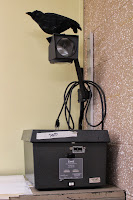 |
| More than just someone to watch over our accolades and team pictures. (10/11/13) |
A morbid, and astute, reader may presuppose that the presence of a murder (or muster) suggests something "bad" is going to happen in this room. Though in Medieval time ravens would tend to congregate on the battlefield to feast on the corpses of the fallen, that depressing intention is not what's behind this style choice--at least not intentionally. Each new school year the presence of the artificial ravens in the classroom elicits a now familiar question from new students: "What's with all the birds/crows/ravens?"
 |
| As fate would have it, this freebie poster was received in my school mail today! (9/1/15) |
- "The Raven" by Edgar Allan Poe: Most students are at least vaguely familiar with the poem if for no other reason than it's pop culture references in many a comedic television aside. For some, even those who've "read" it, the symbolism of the raven is often not so clear. Given the poem's close association with Halloween, they do understand it to be somehow dark or evil. Morbid, right?
- Did you know that good ol' Willy Shakes refers to the raven more often than to any other bird? In a number of William Shakespeare's works such as Othello and Macbeth (a play we will work with during the school year), the black bird makes an appearance. For example in Lady Macbeth's speech in Act I Scene V of Macbeth: "The Raven himself is hoarse/That croaks the fatal entrance of Duncan/Under my battlements...".
- With any luck, we will be reading some excerpts from Keith Baines' translation of Sir Thomas Malory's Le Morte d'Arthur this year, whcih allows for this connection: in Celtic mythology, ravens are often associated with warfare and the battleground (especially in Irish mythology). In Welsh mythology, ravens figure as the army of King Arthur's knight Owain. King Arthur's messianic return is an aspect of the legend of King Arthur, the mythical 6th-century British king. One recurrent aspect of Arthurian literature was the notion that he would one day return in the role of a messiah to save his people. Other less common concepts include the idea that Arthur was absent leading the Wild Hunt, or that he had been turned into a crow or raven.
- A Feast for Crows by George R. R. Martin is the fourth of seven planned novels in the epic fantasy "A Song of Ice and Fire" series of novels. The words "crow" and "raven" play multiple roles throughout the series. The most obvious for those who have never read the books or seen the HBO show is the historical one suggested above: A Feast for Crows clearly suggests (though no surprise to fans) that this book will have a hefty headcount of dead to be eaten. Also, in the Fire and Ice mythology, a "Crow" is the name given to those men who serve on the Wall, the immense ice structure which separates the northern border of the Seven Kingdoms from the lands beyond. Men of the Watch dress entirely in black, giving rise to the nickname "crows"--which is what the Free Folk commonly call them. Finally, characters uses ravens as messenger birds throughout the series. Additionally, the Three-eyed raven appears in Bran Stark's dreams to guide him on a quest. Interesting side note, I had not previously realized: The first name "Bram" is derived from a convergence of two separate etymological sources, one being an abbreviation of "Abraham", but the other being the Gaelic word "bran", meaning "raven". That Martin guy is clever!
- In the past my students and I have read and analyzed J.R.R. Tolkien's The Hobbit (1937), a novel chock full of inetersting tidbits about archettypes and etymology. This was also news to me, but really cool: Roäc is the leader of the Ravens of the Lonely Mountain. Roäc was the son of Carc, and as such "a descendant of those [ravens] that had remained on the hill even after Smaug had driven out their old allies, the Dwarves". Roäc is likely an onomatopoeic name. (Source: Tolkien Gateway)
 |
| Someone has to use the ancient overhead--why not a Raven? (10/11/13) |
 |
| A panoramic view of a classroom surrounded by faux crows circa October 2013. |


No comments:
Post a Comment